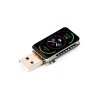






zł37.11 tax excl.
RP2350-LCD-1.47-B is a compact development board with the RP2350A microcontroller and a 1.47" color LCD, designed for rapid prototyping of embedded projects. With support for dual CPU architectures, 16 MB of Flash memory, and a variety of interfaces (USB, TF, RGB LED), it is suitable for educational purposes, demo projects, wearables, and interactive systems. Support for popular development environments and expandability via goldpin headers further enhance its versatility.
A compact development board based on the RP2350A microcontroller designed by Raspberry Pi in the United Kingdom. The chip features a unique dual-core, dual-architecture design – combining Arm Cortex-M33 and Hazard3 RISC-V cores – with a clock speed of up to 150 MHz. The board is equipped with a 1.47-inch LCD display with a resolution of 172×320 pixels (262 thousand colors), 16 MB of Flash memory, a TF card slot, and a color RGB LED. Thanks to its small size and built-in peripherals, it enables rapid prototyping and integration in IoT projects and interactive devices. Version “B” features a USB Type-A port and is delivered without pre-soldered goldpin headers.
Data sheet
Manufacturer BTC Korporacja sp. z o. o. Lwowska 5 05-120 Legionowo Poland sprzedaz@kamami.pl 22 767 36 20
Responsible person BTC Korporacja sp. z o. o. Lwowska 5 05-120 Legionowo Poland sprzedaz@kamami.pl 22 767 36 20
The board with the RP2040 microcontroller equipped with two ARM Cortex-M0 + cores, which operate at a frequency of 133 MHz and 264 kB RAM. The additional ESP8285 system allows communication in the WiFi network. Seeed Studio 102991555
Mini board with the RP2040 microcontroller equipped with two ARM Cortex-M0 + cores, which work at a frequency of 133 MHz and 264 kB RAM. The board also has 8 MB of QSPI flash memory. The system can be programmed in C/C++ or MicroPython. Pimoroni PIM558
The board with the RP2040 microcontroller equipped with two ARM Cortex-M0+ cores, which work at a frequency of 133 MHz, 264 kB RAM. The board also has 8 MB of QSPI flash memory. The circuit can be programmed in C/C++, CircuitPython or MicroPython. Adafruit 4900
No product available!
Base board with soldered Raspberry Pi Pico module. Equipped with numerous connectors, buzzer, buttons and LEDs. Cytron MAKER-PI-PICO-MINI
A kit containing an LED strip driver module and WS2812/Neopixel tape. Designed to easily and quickly create animations using popular RGB LED strips. Pimoroni PIM657
Raspberry Pi Pico 2W, based on the RP2350 microcontroller and has a built-in WiFi and Bluetooth communication module. Pi Pico 2W offers significantly increased performance and functionality thanks to the use of Cortex M33 and RISC-V cores, doubled SRAM memory and advanced security features, including Arm TrustZone. It is hardware and software compatible with previous models, making it an attractive choice for enthusiasts and professionals in the field of embedded systems
RP2350-Touch-AMOLED-1.43 is a high-performance platform for building modern user interfaces in mobile, wearable, and control system projects. The high-contrast AMOLED display and capacitive touch, combined with an IMU sensor and RTC, provide a comprehensive development environment for applications requiring advanced interaction and mobility.
The board with the RP2040 microcontroller equipped with two ARM Cortex-M0 + cores operating at a frequency of 133 MHz, 264 kB RAM. The board also has 2 MB of QSPI flash memory. In addition, the board is equipped with the Infineon CYW43439 system, extending the board with wireless connectivity. Version with soldered connectors. Raspberry Pi SC0919
Board with RP2040 microcontroller and class D mono audio amplifier based on MAX98357 chip. It has a built-in LIS3DH three-axis accelerometer, an RGB NeoPixel LED, a LiPo charging circuit, and a STEMMA QT connector. Adafruit 5768
Raspberry Pi Pico W soldered board module dedicated to matrix displays with HUB75 interface. Pimoroni PIM662
No product available!
The board with the RP2040 microcontroller equipped with two ARM Cortex-M0+ cores, which work at a frequency of 133 MHz, 264 kB RAM. The board also has 4 MB of QSPI flash memory. The system can be programmed in C/C++ or MicroPython. Waveshare RP2040-Plus
Module with a round 1.28" IPS LCD touch display with a resolution of 240x240 px and an RP2040 microcontroller. Equipped with an accelerometer and gyroscope. Enclosed in a nice metal housing. Waveshare RP2040-Touch-LCD-1.28-B
The board with the RP2040 microcontroller equipped with two ARM Cortex-M0+ cores, which work at a frequency of 133 MHz, 264 kB RAM. The board also has 2 MB of QSPI flash memory. The system can be programmed in C/C++ or MicroPython. Waveshare RP2040-Zero-M
Arduino development board with RP2040 microcontroller. Equipped with WiFi and Bluetooth module, 6-axis IMU system with accelerometer and gyroscope, MEMS microphone, RGB LED diode and cryptographic system. Arduino ABX00053
RP2350-Touch-AMOLED-1.64-M is a compact board featuring the RP2350 microcontroller and an AMOLED display, equipped with touch input, motion sensors, and a full set of peripheral interfaces. Designed for modern mobile applications, HMI systems, and experiments with RISC-V and ARM architectures.
A compact and powerful development board featuring the RP2350B microcontroller, featuring a dual-core ARM Cortex-M33 processor and Hazard3 RISC-V processor. It features 520 KB of SRAM, 16 MB of Flash, expandable with PSRAM, a DVI connector, a PIO-USB port, a microSD slot, and a 40-pin GPIO header. The board supports SPI, I2C, UART, and USB communication, and offers 12 programmable state machines (PIOs) and an on-board temperature sensor. Waveshare RP2350-PiZero

RP2350-LCD-1.47-B is a compact development board with the RP2350A microcontroller and a 1.47" color LCD, designed for rapid prototyping of embedded projects. With support for dual CPU architectures, 16 MB of Flash memory, and a variety of interfaces (USB, TF, RGB LED), it is suitable for educational purposes, demo projects, wearables, and interactive systems. Support for popular development environments and expandability via goldpin headers further enhance its versatility.
